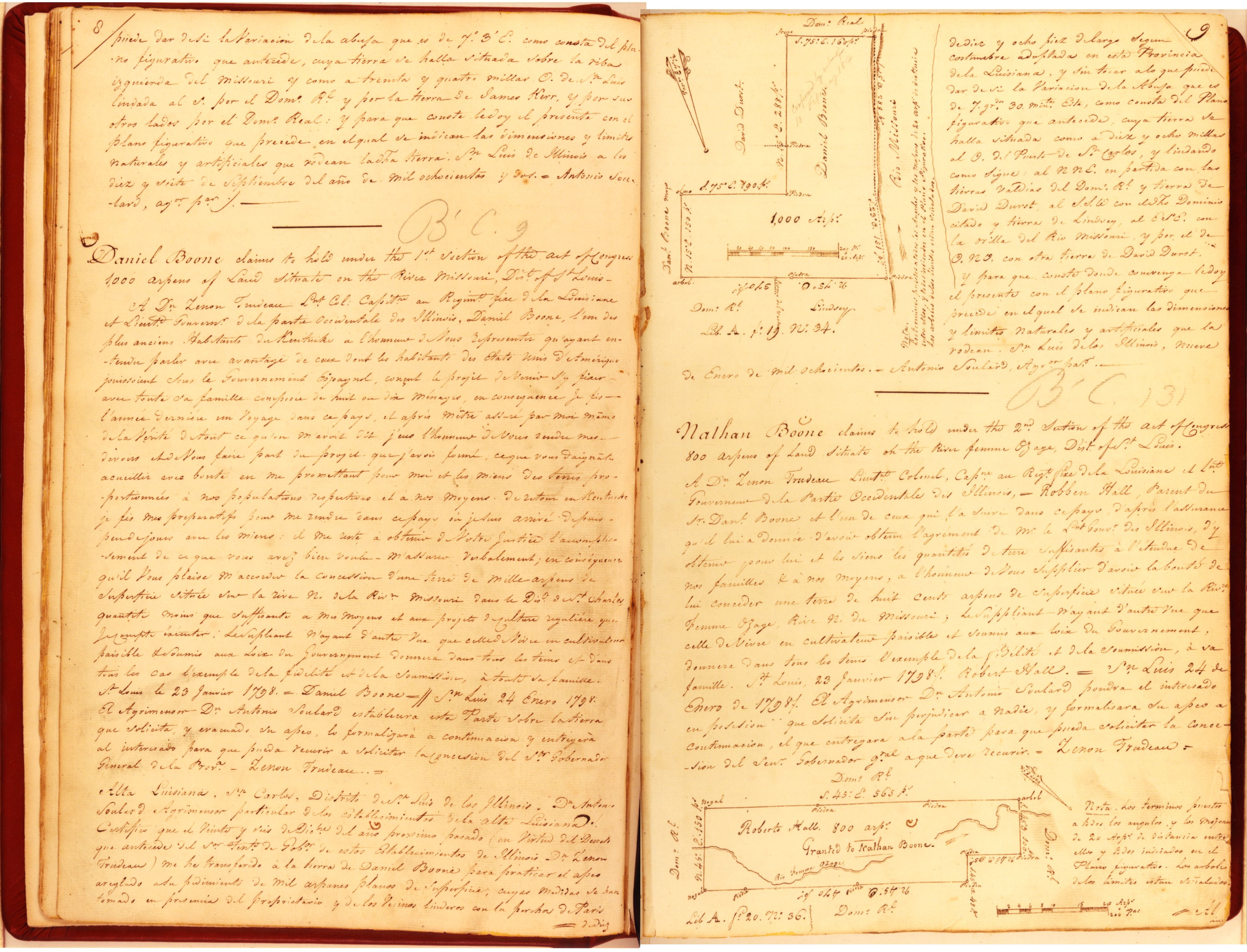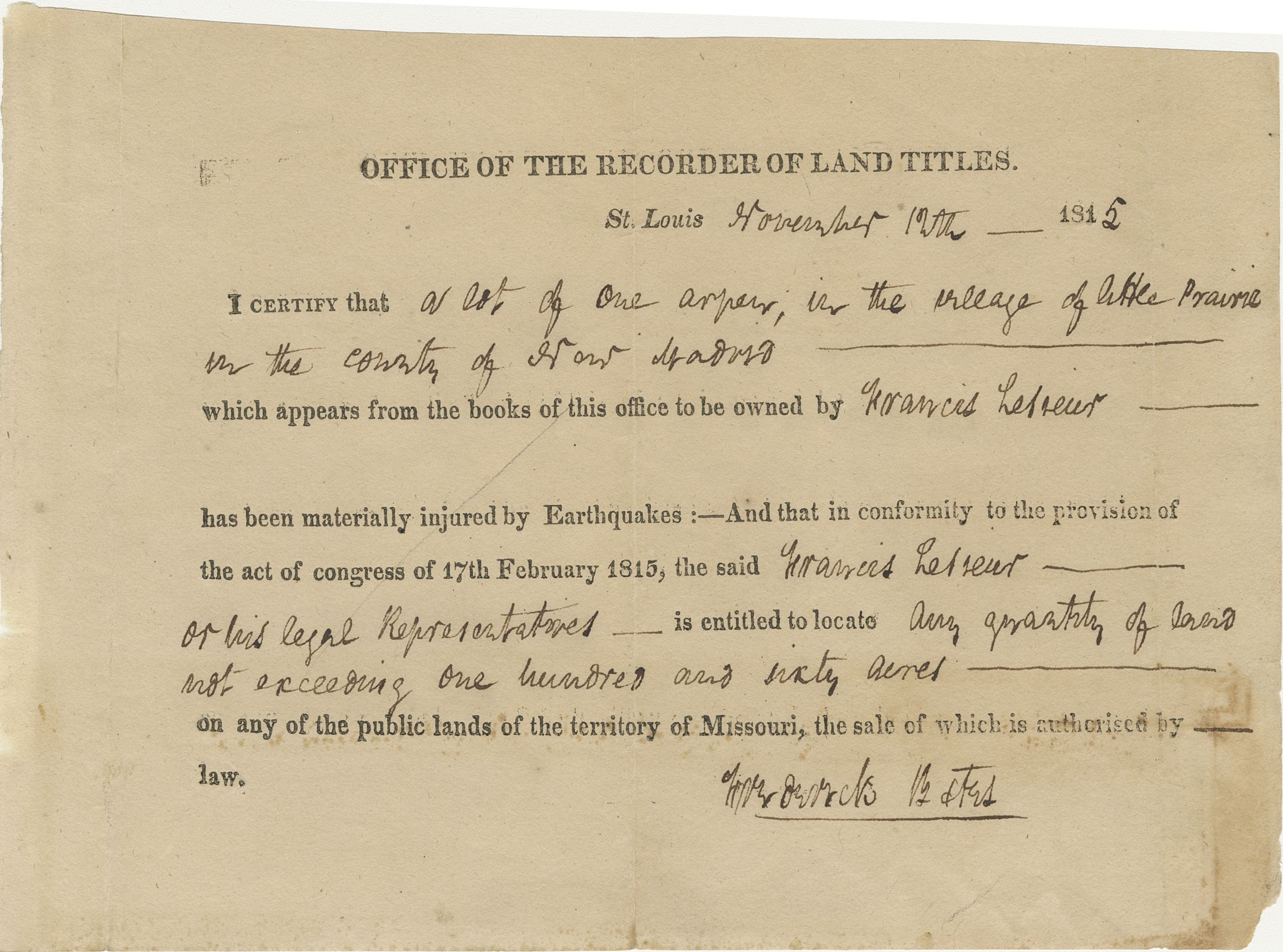| 1673 |
During their voyage down the Mississippi River in the summer of 1673, Father Jacques Marquette and Louis Joliet were the first Europeans to visit what would later become Missouri. |
| 1682 |
Explorer Rene-Robert Cavalier, Sieur de La Salle claimed possession of the Louisiana Territory region for France near modern day Venice, Louisiana on April 9, 1682. |
| 1700 |
Jesuit missionaries established the first European settlement in modern Missouri at the Mission of St. Francis Xavier (near modern Des Peres) in 1700. It was abandoned in 1703 due its swampy location. |
| 1719 |
Workmen for the Compagnie des Indes (Company of the Indies) began digging for lead and silver in the Mine la Motte area as one of the first lead mines in North America in 1719. Due to the physical requirements the next year Phillippe Francois Renault, the main operator of the mine, brought the first enslaved people to colonial Missouri to work as forced labor. |
| 1723 |
In 1723, Fort Orleans was built on the north bank of the Missouri River by Etienne de Bourgmont in modern Carroll County. It was abandoned shortly thereafter. |
| 1750 |
Ste. Genevieve, the first permanent white settlement in what is now Missouri, was founded by 1750. |
| 1762 |
The Treaty of Fontainebleau, which would transfer French Louisiana to Spain, was signed on November 3, 1762. The King of Spain ratified the Treaty on November 13 and the King of France ratified on November 23. |
| 1764 |
St. Louis was founded by Pierre Laclede Liguest along with his stepson Auguste Choteau and other fur traders on February 15, 1764. |
| 1769 |
St. Charles was established by Louis Blanchette as a trading post in 1769. |
| 1770 |
The Spanish government officially assumed control of the Territory of Louisiana on May 20, 1770, which had been ceded to them in 1762. |
| 1773 |
Mine au Breton (later Potosi), an early lead mining settlement, was founded by Francois Azor in 1773. |
| 1787 |
The Northwest Ordinance prohibited slavery in territory north of the Ohio River on July 13, 1787. Some French slave owners in that area moved west of the Mississippi River into Spanish-controlled territory to avoid losing their enslaved people. |
| 1789 |
New Madrid was established by Colonel George Morgan on February 14, 1789. |
| 1793 |
Cape Girardeau was established as a trading post by Louis Lorimer along with other French Canadians on January 4, 1793. Later that year, a land grant was granted to members of the Shawnee and Delaware. |
| 1798 |
In an effort to bring more American colonial settlers to the area, Spanish Lt. Governor Zenon Trudeau granted frontiersman Daniel Boone 1,000 arpents of land to settle in the Louisiana Territory on January 23, 1798. |

RG951, Record of Land Titles, Volume C, page 8-9, Daniel Boone
|
| 1800 |
Spain returned the Louisiana Territory to France with the Third Treaty of San Ildefonso on October 1, 1800. |
| 1803 |
The Louisiana Purchase, between France and the United States, was signed on April 30, 1803 doubling the size of the United States. |
| 1804 |
William Clark, Meriwether Lewis, and the Corps of Discovery set out from St. Charles on May 21, 1804. |
| 1804 |
The District of Louisiana was organized on October 1, 1804 and was under the administrative control of the governor of the Indiana Territory. |
| 1804 |
The original five districts of Missouri were created on October 1, 1804 by proclamation from Gov. William Henry Harrison: Cape Girardeau, New Madrid, St. Charles, St. Louis, and Ste. Genevieve. |
| 1804 |
The Treaty of St. Louis was signed on November 3, 1804 in Portage des Sioux by William Henry Harrison, governor of the Indiana Territory and District of Louisiana, and representatives from the Sac (Sauk) and Fox ceding land in Missouri, Illinois, and Wisconsin to the United States Government. |
| 1805 |
Nathan and Daniel Morgan Boone partnered with James and Jesse Morrison in 1805 to produce salt in modern Howard County. The Boone’s Lick Road from St. Louis to the Salt Lick, and later Franklin, was a major contributor to the rapid settlement of the lower Missouri River Valley. |
| 1805 |
The Territory of Louisiana was established with the seat of government at St. Louis on March 3, 1805. |
| 1806 |
The District of Arkansas was established on June 26, 1806 becoming the sixth district of Missouri. |
| 1807 |
The General Assembly of the Louisiana Territory enacted legislation on June 27, 1807 allowing enslaved persons to sue for their freedom. |
| 1808 |
The first newspaper in Missouri, the “Missouri Gazette” was first published on July 12, 1808 by Joseph Charless. |
| 1808 |
The Treaty of Fort Clark, the first treaty with the Osage, was signed on November 10, 1808. It established Fort Osage in future Jackson County as a federal trade post where furs could be exchanged and specified payments for land. It also established Osage hunting rights within ceded lands and provided for dispute resolution. |
| 1809 |
The Missouri Fur Company was organized in St. Louis in 1809. Prominent members of the Company included Manuel Lisa, Auguste and Pierre Chouteau, and William Clark. The abundance of animal furs in the west played a key role in the development of the Upper Louisiana territory. |
| 1811 |
On December 16, 1811, an earthquake with an epicenter in southeastern Missouri was estimated to be a Richter scale magnitude of 7.5. The most powerful in U.S. history east of the Rocky Mountains, the quake decimated over 200,000 square miles of land including the town of New Madrid and rang church bells as far away as Philadelphia and Boston. Subsequent quakes and aftershocks lasted into April 1812 displacing settlers in the region. |
| 1812 |
The Territory of Louisiana was renamed the Territory of Missouri on June 4, 1812 after the Territory of Orleans became the State of Louisiana. |
| 1812 |
The first session of the Missouri’s territorial General Assembly met in St. Louis on October 1, 1812. Every tax-paying white male was able to vote for members of a territorial House of Representatives. The upper house, the Legislative Council, consisted of nine members appointed by the President. |
| 1812 |
Territorial Governor of Missouri, Benjamin Howard, issued a proclamation on October 1, 1812 making the previously established districts into counties. |
| 1813 |
The original counties of Missouri were organized by law on December 31, 1813 by “An Act establishing counties and county lines.” The original counties were Arkansas, Cape Girardeau, New Madrid, St. Charles, St. Louis, Ste. Genevieve, and Washington. |
| 1815 |
Lawrence County was established from Arkansas County on January 15, 1815. The majority of Lawrence County became Lawrence County, Arkansas when the Arkansas Territory was created in 1819. |
| 1815 |
The New Madrid earthquakes spurred the country’s first Congressional disaster relief legislation, “An act for the relief of the inhabitants of the late county of New Madrid, in Missouri Territory, who suffered by earthquakes” was signed on February 17, 1815. The act allowed displaced settlers to relocate their lands elsewhere in the territory. |

RG951.03, New Madrid Claims, Francis Lesieur
|
| 1817 |
The steamboat Zebulon M. Pike, the first steamboat to navigate the Mississippi River above the mouth of the Ohio, reached St. Louis on August 2, 1817. |
| 1818 |
A petition to Congress from Missouri requesting statehood was presented by the Speaker of the U.S. House of Representatives Henry Clay on January 8, 1818. |
| 1818 |
The first U.S. Land Sale in Missouri was recorded at the St. Louis District Land Office on July 13, 1818. |
| 1820 |
The Missouri statehood controversy became a national issue as slavery was debated during the "Missouri Compromise" on March 6, 1820. The Missouri Compromise allowed Maine to enter the Union as a free state, Missouri to enter as a slave state, with the provision the remaining portion of the Louisiana Purchase north of the 36° 30’ line would have slavery “forever prohibited” thus keeping the balance of slave and free states equal in Congress. |
| 1820 |
Missouri’s “Enabling Act” formally known as the “An Act to authorize the people of the Missouri territory to form a constitution and state government, and for the admission of such state into the Union on an equal footing with the original states, and to prohibit slavery in certain territories” was passed by Congress and then signed by President James Monroe on March 6, 1820. |
| 1820 |
The first Missouri Constitutional Convention met at the Mansion House Hotel in St. Louis. Written in only 38 days, the first Missouri Constitution was adopted on July 19, 1820. |
| 1820 |
Missouri’s first state election was held on August 28, 1820, and Alexander McNair was elected as the first governor. |
| 1820 |
Missouri's first General Assembly began its session on September 18, 1820 at the Missouri Hotel in St. Louis. |